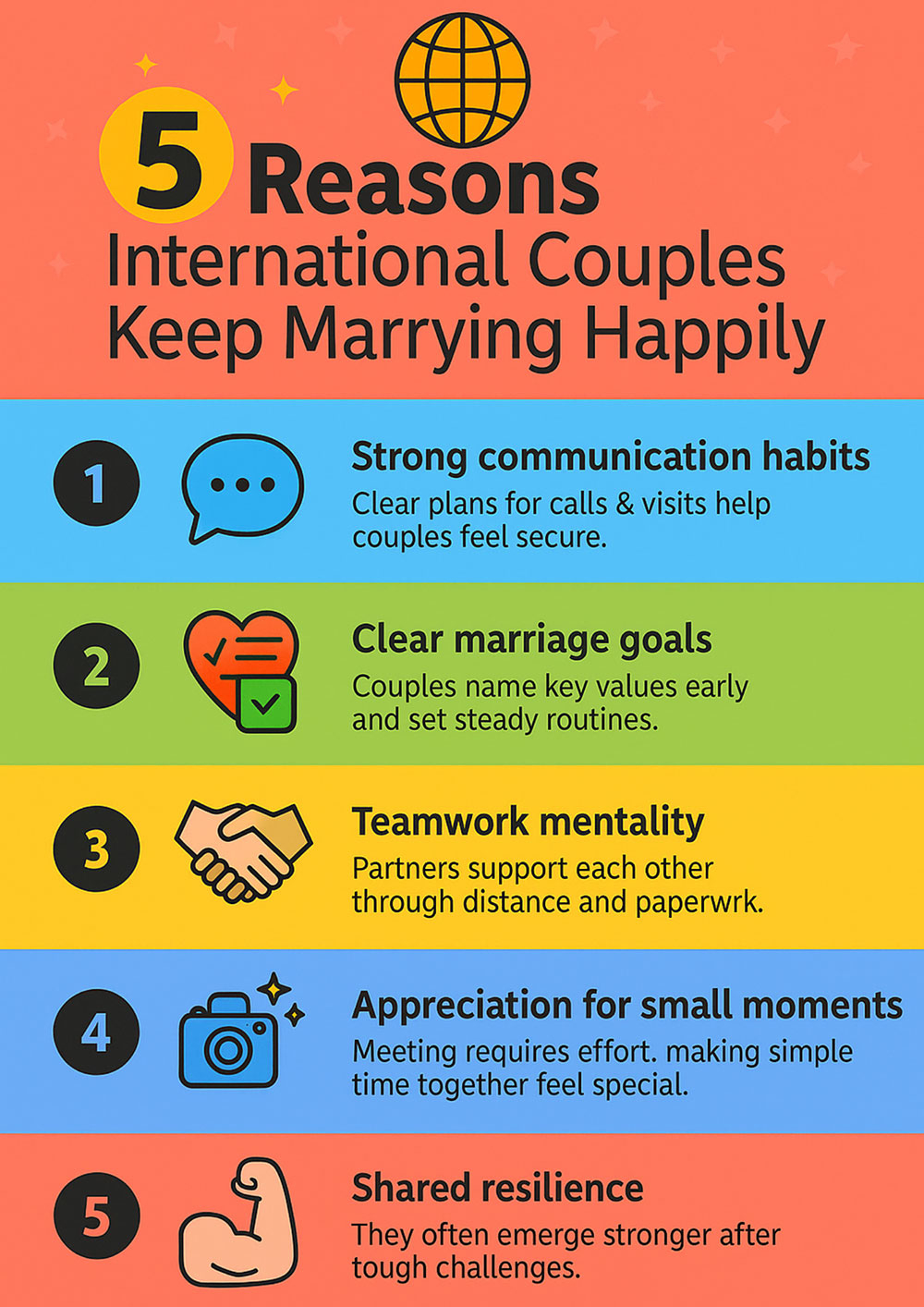I sit with couples from every corner of the map. Some met on vacation. Some met in college. Many met online and fell for a person who lived a world away. The rise of cross-border love isn’t a fad. It’s a shift in how people meet, talk, and build homes. In this piece I’ll show how common these marriages are now, tell three true-to-life client stories, name typical hurdles with fixes that work, and point to quiet strengths that help these couples stay close. If you’re interested in, you’re in the right place.

How Common International Marriages – and Online Dating – Are Now
Fifteen years ago, most of my couples met through school, church, or friends. Today, a growing share arrived through a chat window or a dating app that widened the map. International dating sites no longer feel fringe. They sit right next to your standard apps, only with translation tools, video calls, and better ways to verify identity. When two people click, distance feels less scary and more like a puzzle you can solve with calendars, flights, and honest talk.
The second reason for the rise is simple: travel and remote work expanded options. You can live in Austin yet work with a team in Lisbon or Manila. You can plan a real first date in a new city and keep the bond warm with clear routines. Friends used to warn, “Long distance never lasts.” The data and the lived reality tell a different story. Couples who plan call times, set visit dates, and keep promises often report high satisfaction because they learned early to communicate on purpose.
Online tools also reduce guesswork. Video chats show tone and timing, not just words. Short clips from daily life – a kitchen tour, a commute, a walk with a parent – give context that a profile never could. Add in better ID checks and safer payment rules, and you get a space where real people can find each other without chaos. Smart couples also add old-school checkpoints: meet a friend or sibling on video, swap a few family stories, ask simple questions about work and weekends, and look for steady answers.
Finally, there’s a cultural shift I love. People now talk more plainly about marriage goals. They want loyalty. They want kids or no kids, and they want to say that out loud before year two. When someone in Bogotá and someone in Boston want the same future, distance becomes a math problem, not a deal-breaker. I see more cross-border weddings now, and many of them carry clean expectations into day one. If you need ideas for planning, a resource like the Aspen Wedding Guide can spark venue and timeline thoughts even if you end up marrying in a different state or country.
Stories From My Practice
I’ve changed names and small details, yet the heart of these stories remains true.
Sofia & Mark – The Calendar Saved the Day
Sofia grew up in Portugal and taught high school literature. Mark worked in tech in Seattle. They met in a comment thread, not on a dating app. Their early weeks felt dreamy, then time zones bit hard. Missed calls led to hurt feelings. We built a simple plan: two fixed call slots per week, one flexible slot for busy weeks, and a short daily check-in with a photo or voice note. They also wrote a six-month plan: one visit in spring, one in late summer, and a “state of us” talk after each visit. The calendar calmed the nerves. The steadiness made space for warmth. They married two years later and still keep a monthly check-in.
Hana & Eli – Two Faiths, One House
Hana worked as a nurse in the Philippines. Eli managed a small bike shop in Chicago. Values lined up on family and money, yet faith practices differed. The solution came through respect, not debate. We wrote a holiday pact: what to keep from each tradition, what to build together, who visits which family and when. Both sides agreed to learn three songs or prayers important to the other. Their parents felt seen. The couple felt united. That mix gave them a home that felt calm and real.
Oksana & David – Visa Stress, Strong Team
Oksana, a Ukrainian engineer, met David, a chef in Dublin, on an international dating site with solid ID checks. They clicked fast, then hit paperwork stress. Delays spiked frustration. We built a “paperwork file” in the cloud with receipts, copies, timelines, and a weekly 30-minute admin slot. They kept romance separate from admin. They also added a rule: no major fights during paperwork time. If tension rose, they paused and returned later. The visa came through. Their relief came from process, not luck.
Common Difficulties – and How to Solve Them
Cross-border love brings predictable stress. The good news: most of it yields to simple systems.
- Time zones. Set fixed call windows. Add one quick daily touch by voice note or photo. Name one day per week as “low-pressure mode” if work explodes.
- Money talks. Share salaries, debts, and savings. Build a joint budget doc with three buckets: now, near-term, long-term. Review it monthly and keep receipts in one folder.
- Language gaps. Learn ten words per week in each other’s language. Food, feelings, and money terms first. During conflict use slower speech and shorter lines.
- Family expectations. Write a holiday pact and a visit plan. Decide who pays for flights. Keep private tension private. Present a united front in public.
- Paperwork and visas. Create one shared checklist and timeline. Store scans of every form. Set a weekly admin block. Agree to pause fights during admin time.
- Jealousy and trust. Define deal-breakers. Agree on fair phone rules. Share your social plans in advance when travel or late nights may cause stress.
- Uneven roles at home. Write a chores map with a backup plan for sick weeks. Revisit it every quarter. Trade tasks once in a while so no one feels stuck.
The Non-Obvious Advantages of International Marriages
Some perks don’t show up on a dating app bio. They show up later, and they make a big difference.
Better Conflict Hygiene
Many cross-border couples learn to speak clearly out of need. They plan talks. They use a calm tone. They summarize key decisions in writing. These habits prevent months of guesswork and keep fights from spiraling.
A Wider Family Net
Two families across two regions can feel like a hassle. It can also give you more hands in a crisis, more wisdom at holidays, and more chances for the kids to feel loved by many people, not just two.
Stronger Gratitude Muscle
When visits require savings and planning, couples savor small moments. A shared meal. A clean apartment. A repaired misunderstanding. Gratitude shows up often because nothing gets taken for granted.
A Real Language Boost
Learning each other’s tongue builds empathy. You slow down. You listen harder. You laugh at mistakes together. That mindset carries into every part of the home.
Kids With Cross-Cultural Confidence
Children in these homes learn to read rooms across customs, foods, and faiths. They grow flexible without losing roots. They also learn early that respect opens doors.
Why International Couples Are Increasingly Creating Happy Marriages
I’ll keep this simple. These marriages work because they force good habits early. You can’t coast on charm when your partner lives six time zones away. You build a schedule. You name values. You write rules you both accept. That structure doesn’t crush romance; it protects it. Candor stays high. Surprises stay low. When issues show up, you solve them with a plan, not a threat.
International couples also marry with a deep sense of choice. Neither person “just happened” into the relationship. Travel, paperwork, and long calls require intention. That mutual choice builds respect. Respect builds trust. Trust builds warmth. Warmth makes space for fun and play, which keeps a house happy through long weeks.
Then there’s grit. These couples handle customs lines, missed flights, slow visas, and language slips. They become a team against the problem. The mindset shifts from “me vs. you” to “us vs. the storm.” That habit shows up later in parenting, job changes, and health scares. It’s the reason so many report high satisfaction after the dust settles.
If you’re on the fence, you don’t need a fairy tale. You need a plan. Start with a clear profile on a reputable site. Move to video early. Set call windows and visit dates. Write a holiday pact and a chores map. Keep a paperwork file if visas enter the chat. Add one rule for fights: no name-calling, no threats, cool-off windows allowed. Do this, and you give love a fair chance across borders.
“Pick each other on purpose. Then keep picking each other when life gets loud.”
Quick Starter Kit You Can Screenshot
- First message to video: within two weeks if you feel safe
- Calls: two fixed slots weekly, one flexible slot for chaos weeks
- Visits: set the next date before you end the current one
- Docs: one shared folder for money, travel, and later paperwork
- Rules: no public shaming, no silent treatment, repair within 24 hours
Conclusion
International marriages aren’t rare anymore. They’re a normal path to a good home when two adults set clear goals and protect the bond with habits that last. The best part isn’t the stamps in the passport. It’s the daily proof of care – kept calls, honest money talks, respect for family, calm repair after a fight. If you both bring honesty, kindness, and grit, you can build a house that feels safe and warm no matter where you started. Flags differ. Love rules stay the same.
About the Author
Peggy Bolcoa, LMFT, PhD is a relationship psychotherapist and writer who helps couples build steady homes with clear rules and lots of heart. She works with cross-border pairs on communication, conflict repair, and family harmony. Off the clock she sips tea, reads novels, and spoils a very opinionated dog.






